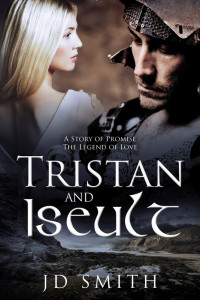 Historical romance comes no more romantic than the iconic legend of Tristan and Iseult (Isolde) in all its many variations – from Wagnerian melodrama to plays, films, myths, and fairy tales – often with a plethora of magicians, nymphs and mysteries as befitting an ancient narrative.
Historical romance comes no more romantic than the iconic legend of Tristan and Iseult (Isolde) in all its many variations – from Wagnerian melodrama to plays, films, myths, and fairy tales – often with a plethora of magicians, nymphs and mysteries as befitting an ancient narrative.
A challenging prospect for a first novel, but J. D. Smith cuts her own path through the medieval forest with quiet confidence, stripping away fantasy to focus on the relationship between the two thwarted lovers; simplicity which gives the story an intriguingly modern feel while retaining its historical context.
For those less familiar with the legend – set in Arthurian times in ancient Briton – the Romans have gone, leaving a patchwork of small tribal domains of wavering fortunes, threatened by invading Saxons intent on taking over the entire country. Barbarians howl at every gate. While from across the sea, the Irish menace Briton’s west coast with demands for tribute of gold, livestock and grain.
Caught between these two forces, King Mark of Kernow (Cornwall), sends his only son Rufus and his nephew Tristan to help the neighbouring kingdom of Dumnonia defend itself against the Saxons, while he seeks a diplomatic solution to the Irish problem. Against this volatile political background, individuals play out their divided loyalties and passions, coping as best they can with external powers that manipulate their lives.
We first meet young Tristan, competent swordsman and mentor to the younger, less experienced Rufus, as they encroach on a Saxon camp for a surprise dawn attack. Taut with cold and anticipation, Tristan begins the story:
“Rustling emanates from the dense forest, even though the wind has dropped. White mist shrouds us. I tense to stop cold shivers taking hold. The rain is fine, yet a hand through my hair proves it is wetter than the streams in springtime and my footing slides on the muddy grass as we pick our way through undergrowth…the cold and the quiet and the waiting; they let thoughts run too free.”
Iseult lingers on a beach in southern Ireland; a ‘princess’ whose father has been killed by his powerful rival, Lord Morholt, leaving her mother and herself in a precarious position. The mother’s solution – acquiescence in a marriage of alliance between Iseult and the tyrannical Morholt – is a future fate Iseult has little option but to accept. She finds solace in the wind and waves of the seashore in her pre-dawn wanderings:
“I lie on the gritty shore. My eyes are closed and my hair is full of sand. The wind drags spray that dries on my lips. I taste it: salty, abrasive, clean. Gulls cry overhead. I am cold and the ground and the air and my skirts are all damp. I shiver. Close my eyes tighter. Stop them watering. Prevent the tears trailing more salt down my cheeks.”
When Morholt sails to Kernow to challenge King Mark in a ‘winner takes all’ bloody confrontation, he takes Iseult with him. Tristan and Iseult first meet from opposing camps, but the outcome of that combat changes everything.
The novel’s structure – chapters alternating between Tristan’s and Iseult’s points of view – written with the immediacy of the present tense, draws us into unfolding events that bring them closer together while, inevitably, holding them apart. Their respective reactions to the trials and demands that impugn their growing passion for each other creates increasing tension, released only after a final, devastating act of treachery.
The distinctive characters of Tristan and Iseult are well drawn; emerging from their pasts and their differing opportunities to take control of their lives. Supporting roles are equally convincing: King Mark, statesman struggling with human vulnerability; Isuelt’s motherly maid, Acha, pulled between comforting her charge and concern for her own survival; the abominable Morholt with the stinking breath and abhorrent habits, and Tristan’s widowed mother, perceptive, affectionate and emotionally overwhelmed by loss.
Small descriptive touches are evocative: as they approach a skirmish with the Saxons, “leather creaks in time with our pace”; armour needs constant attention, “scales rust fast in the damp air”. Battle scenes of close encounters with sword and axe are vivid but not gratuitously gory. But I would have enjoyed clearer depiction of interior settings: Tintagel Castle, for example, where Iseult plays the harp in the banqueting hall, and embroiders with Tristan’s mother in a small chamber; more detail would have enhanced the sense of place and period.
For devotees of historical romance, Tristan and Iseult is an absorbing and satisfying read. The presentation is excellent and the cover as attractive as one would expect, given that Jane Dixon-Smith is also an accomplished graphic designer; I hope she finds time for future novels. She is a member of the writers’ collective Triskele books – you can access their website here > triskelebooks.co.uk > and follow them on Twitter @TriskeleBooks.
I read the Kindle edition of Tristan and Iseult, from Quinn Publications, 13 May 2013, ASIN: B00CS5X020.
